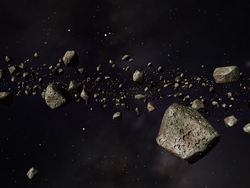Asteroids captured as orbiting spaceports
Sending a spacecraft up to an asteroid whose orbit has come close to that of Earth, grabbing hold of it and placing it in orbit around our home planet may sound like a science fiction scenario. However, according to EU-funded researchers' calculations, a demonstration mission to such a near-Earth object could be possible within the next decades. Within the project ASTEROIDRETRIEVAL (Asteroid retrieval missions enabled by invariant manifold dynamics), researchers calculated trajectories that can lead an asteroid towards the Earth's orbit. By slightly changing the velocity of a near-Earth asteroid, it could be placed on a trajectory where it will be eventually captured by the gravity of our planet. The project team used the laws of celestial mechanics to calculate suitable trajectories for capturing near-Earth asteroids with the lowest possible energy consumption and risk for impact with the Earth. They also assessed the feasibility of such an endeavour, concluding that it could be attempted in as little as 10 years. Specifically, the researchers have identified 15 suitable targets that could be retrieved with current space propulsion technology. They also modelled the combined gravitational effects of the Earth, the Sun and the Moon. Lastly, theoretical predictions were incorporated in the design of complex engineering systems needed to redirect an asteroid in space. ASTEROIDRETRIEVAL was a continuation of research work begun in the EU-funded project VISIONSPACE(opens in new window). While investigating asteroid manipulation, the concept of asteroid capture attracted the attention of the researchers who published the first results in 2012. Shortly after, the National Aeronautics and Space Administration (NASA) announced its plans for the Asteroid Redirect Mission in the mid-2020s. With this mission, the United States space agency wants to bring back rock samples for scientific analysis in the lab and to ward off threatening asteroids. To this end, NASA has focused on orbits around the Moon and ASTEROIDRETRIEVAL on geocentric orbits. While the technology to enable such missions is only at an early stage, ASTEROIDRETRIEVAL has demonstrated that such a mission will be feasible in the near future. Researchers are optimistic and say less than two decades, but it mainly depends on budgets and new technologies that should come along.




